After talking with Alejandro at our Hostel Maloka, it was an easy decision to reserve a guided tour to Guatapé, one of the country's largest lakes and close to a gigantic rock called El Peñón de Guatapé that we intended to climb. After all, the tour included stops in two towns, a boat tour on the lake, plus both a small breakfast and lunch. The cost was a very inexpensive 79,000 pesos or about $27 each for about a 12-hour guided tour. How could we possibly beat that price doing it by ourselves?
We had to meet the guides (one Spanish-speaking and one English-speaking) and other participants at the nearby El Poblado Park at 7:30. The park was the site of the First Settlement or (poblado) in the valley. We got there early so had time to walk around the park for a few minutes.
The statue in the park honored the First Settlement.
Since the tour began late (that seems to have been the norm here, thus the term 'Colombian time'), we also had time to pop into San Jose Church, built in 1904, across the street for a few minutes even if I wasn’t able to stay for Mass, Janina!
I know you’d commented after reading in the Cartagena post that we’d seen Pope Francis that that ‘excused’ me from going to church today but we were there at 7:15, i.e. the same time I meet you and Pat for Sunday Mass at St. Frances Cabrini!The stained glass windows were pretty.
Instead of using a collection plate, a lock box was used.
Janina: Just to let you know the time we were at the church and I was thinking of you! BTW: I had to buy this el cheapo watch in Santa Marta when my battery had run out just about a week into the trip. Oh well, the new one was far cuter!
After driving for an hour, the bus stopped for us to enjoy a
quick breakfast comprised of arepa, one of the most popular foods in Colombia. There are different versions of arepas throughout the country which are the equivalent of tortillas in Mexico and bread in Italy. The arepas were served with cheese and huge
cups of hot chocolate. It was customary, we were told, to put the cheese in the
chocolate for it to melt.
The modern bus, akin to a Greyhound, was filled with tourists from all over the world. We were still surprised to chat with women who, like Kristina and Patricia, the two German women we had met separately, were traveling for extended periods by themselves. For whatever reason, the last few years we’ve encountered far fewer men traveling solo than women. I could never do that as it would be too lonely for me and I wouldn’t feel as safe and secure as I do with Steven. Plus, he’s a great Sherpa when needed as well as my tech guru, navigator on the road and all around perfect travel companion! Oh, did I also say he's the love of my life?!
After the Spanish guide had given her spiel each time, then McCoy, the English guide, would translate it for all the other people on the tour. In my opinion, it seemed a waste of time not to separate the group into two so each language group could each see more at every stop. For simplicity's sake, I'll just refer from now on to our guide, McCoy.
In every small town, he informed us there’s a main plaza and always a church in front of it. He also suggested that we look for the crosses on the floor of the church later during our 40 minute free time!
First though, McCoy led us on a brief tour of the town. The most important place was the Plaza of the Heroes as it contained the names of the men who died while fighting for independence in 1810. One local woman lost her husband and ten of her children in the struggle. I cannot even begin to fathom her grief.
He then pointed out the different sized doors in the temple or church across the street. The larger one was for the Spaniards and the smaller one for the locals who bowed as they entered it.
'Homework' time next! Luckily, it was pretty easy to spot the tree in the plaza as it was so much taller than all the others.
The sight of Jesus's face carved into the tree was very unusual and quite moving.
It didn't appear there was much to do in Maranilla except to wander around the small plaza and then see the church.
It was nice that we didn't have to rush and could just dawdle if we felt like it. People watching took up time, too, in the quaint town.
There was standing room only in the church, both outside and inside. The congregation were both young and those less young unlike most US churches on a no-holiday Sunday.
Just before leaving, we saw one of the crosses on the floor that McCoy had suggested we look for.
We had been on the main highway to Bogota but, leaving Maranilla, the guide warned us that the road would be very narrow and windy. Therefore, if we thought we might be car sick (or is that bus sick?), we’d better tell her in advance as she had bags available just in case! Luckily, nobody was – phew!
Mc Coy announced there were three choices for lunch: a fish dish, a chicken one and a sausage one, each with lots of sides. He took everyone’s requests so that the restaurant up ahead in Guatapé would be able to prepare for our invasion. As you can see, we chose the chicken option. We were warned that, if we lost our ticket, we would have to buy our own meal!
The road to Guatapé was filled with attractive farmland and sheep grazing on the hillsides. In the fields, onions, potatoes, strawberries, beans and corn were being farmed.
Before we arrived, McCoy explained the old town of Guatapé had been flooded to make way for an hydroelectric dam built to provide one third of all the electricity in Colombia. The town's women had stood together and refused the government's offer to buy their houses. They held out until he government finally agreed to build a new town of Guatapé and provide new accommodation and infrastructure in the town for everyone.
The first thing to be built in the new town was the cemetery and the church. The town’s residents were extremely religious and hadn’t wanted their old church destroyed. Work was done in the middle of the night to flood the area where the church had been, to the extreme consternation of the citizens. Only the old church tower and cross were still visible in the water but, at different times of the year, the village can still be seen under the water.
The Phoenix sculpture represented the women of Guatapé who refused to capitulate to the government. In the sculpture, the woman’s right hand pointed to the past and her left hand to the new town while she looked at the sky representing the future, McCoy told us.
Our initial view of the amazing El Piedra del Guatapé or the Rock as I will refer to it from now on. The Piedra del Penol is also known as El Penol de Guatapé because of the fierce rivalry between the two towns it straddles.
If you look really closely, you might just be able to spot the white letter 'G' representing Guatapé on the side of the Rock. They were prohibited from continuing, however, because the Rock was considered a natural heritage.
The Rock was a giant, limestone monolith with a peak of 2135m or 7,000 ft above sea level that was formed some 70 million years ago. It had a fissure in it all the way from the bottom to the top of the rock. After it was climbed for the first time in July, 1954, a stairway of 649 steps was built to reach the Rock’s peak.
The 220m or 660 foot high rock has been climbed and descended in as little as just 45 minutes. We didn't care about that record. Our goal was to simply get up to the top and down in one piece!
There were 649 steps to the top of the rock and an additional 91 to the tower. That meant we only had another 599 to go, not including to the tower. That seemed so daunting at that point.
The view of the half natural, half man-made lake and the appearance of islets was stunning from that low point. How much more beautiful could it get, we wondered, the higher we climbed?
At a little over the 100 step mark, we were both dragging more than a bit but there was no option other than to keep going as it was one way only and that was up!
These plants grew out of the vertical cliff face.Seeing this gorgeous view, we were looking forward to our boat ride a little later in the afternoon. We tried to fool ourselves that we just wanted to stop and admire the stunning vistas all around us and that we didn’t need a breather after all the huffing and puffing!
We finally got in the groove and the climb became easier around the 200 step mark. Steven only needed to use his inhaler right at the beginning which was a good sign.
Fortunately we didn't need to avail ourselves of assistance!
We were both thankful the tour company had arranged lunch after the climb as hiking those steps on a full stomach would have been very uncomfortable.
After 'only' about 30 minutes - and that included time for pictures! - we reached the top and the so familiar meeting point sign we've seen all over the country and especially in many Middle Eastern nations, too. I always wonder what would precipitate needing to have a meeting point and how often they are used. But, in this instance, it was a very welcome sight after huffing and puffing our way all 649 steps.
Of course, the view from this spot was the same as it had been 500 steps lower but it was sweeter knowing we had managed to do it. But we couldn't rest on our laurels for long as we had another 91 steps to reach the final overlook from the tower.
Here we were at step 740 with some of our 'friends'!
It was a point of pride that we made it up to the summit and that we had plenty of time there to take even more photos and just relax a bit before heading back down where a delicious lunch was awaiting us soon.As we began the descent, we both found it almost harder than the ascent even though our knees are in great shape, even if other parts of our bodies aren't!
It went quickly but we had to watch our steps more closely as some of the steps were quite slippery because of the moisture coming through the rock.
After a yummy, but far too big a lunch as most Colombian meals are, we had some time to walk around the tourist shacks selling knickknacks. Nothing appealed in them but the sight of a brightly decorated bus driving very slowly along the road at the base of the Rock blasting deafening music while everyone on board danced brought a smile to everyone's face.
It seemed quite amazing that we managed to climb all those steps, considering we were decades older than almost everyone else we'd seen climb.
The tower at the top of course!
The tour left the Rock at 1:30 for a visit to the new town of Guatapé. McCoy said that in 1919, a smart local man sketched lambs on the low walls of his house as it had been customary for people to attend church with their lambs. He had done that because it was so difficult to have 100 or more real lambs at church. The practice of having these decorations or zocalos on the base of the walls became the norm and now the town is known as the City of Zocalos.
The first zocalos:
I, like several others on the tour, had difficulty keeping up with the guide as we were so entranced with the different zocalos and couldn't stop taking photos.In the background was Our Lady of Mt. Carmel Church located in Simon Bolivar plaza. That was the same name of the church I grew up attending with childhood friends Lina, Christine and Mary Pat in Ottawa.
McCoy pointed out the four murals at the base of the church and explained they represented Apostle John as the eagle, Luke as the ox, Mark as the lion and Matthew as the angel as he spread messages of hope.
This was the interpretation of Matthew:
McCoy mentioned that it was often
easy to determine who lived or worked at a certain place because of the design
of the zocalo there. This was obviously a bakery.
The roses indicated a woman named
Rosa lived there.
This building used to be a kindergarten but it was now the registry office. The entire town was a photographer's dream or even a wannabe's one like myself. The houses were painted with such brilliant hues and there were zocalos on almost every building to attract new residents to the town as not everyone from the old town had moved to the new town when it was mostly destroyed. I was confused by that because I had understood McCoy to say earlier the entire old town of Guatapé had been obliterated.
McCoy said the Natchez family was responsible for painting and building most of the zocalos in the town.
The Street of Memories contained homes whose windows had been brought to the new Guatapé. The zocalos were simpler here because they were the first ones. No cars or motorcycles were allowed on the heritage street.
Around the plaza were social houses.
I almost hated to tear myself away until later for the next part of the tour, an hour-long boat tour although about 15 minutes of it was spent waiting for more passengers!
Before leaving Denver, I had heard about the boating accident on Laguna Guatavita. The boat had 170 passengers on it when it capsized and caused the drownings of seven older people who didn’t know how to swim. I hadn't realized, though, the partially submerged boat was so close to the port. As a result of that disaster, it was no longer optional to wear life jackets while out on the lake. Now the police fine offenders 80,000 pesos, about $28.
As we whiled away time on the boat, we reminisced about other boat trips we’d enjoyed on previous journeys. We’ve always found our boat trips have been one of the highlights of each of our adventures. One that stood out for both of us was the overnight one in 2015 on Halong Bay in northern Vietnam.
A view of the Rock:
The boat trip through the islands was an absolute delight in the early afternoon sun but it was chilly when the winds picked up and the captain turned around and headed back toward the dock.
In far too short a time, for me at least, we were back on terra firma.
We took in the sights and smells as we wandered by ourselves along the Malecon, a word used in South American countries for an esplanade or seawall. We will be visiting other malecons later in our trip, too.
Mass was again being celebrated so we didn't get to see any more of the church.
Where in the world is Steven?!
I was glad that we had timed our visit to Guatapé for the weekend as the town was packed with tourists and there was almost a festival atmosphere in the pleasant holiday town. Our day trip to the Rock and the sweet little town made us glad that we had included Medellin on our itinerary after all.
Next post: The alluring city of Bogota.
Posted on September 22nd, 2017 from Villa de Leyva, Colombia.
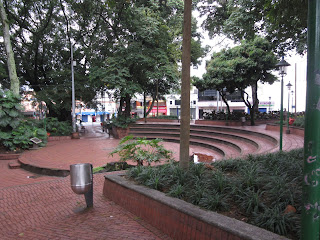











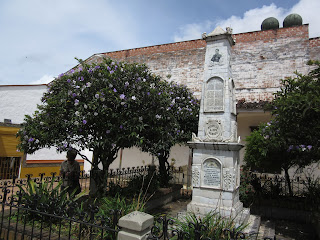






























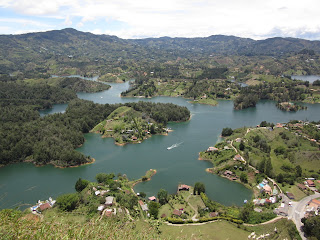






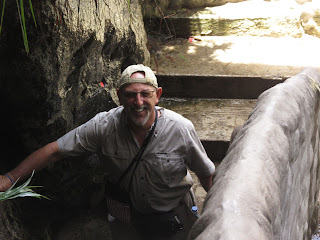



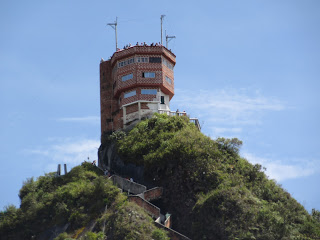

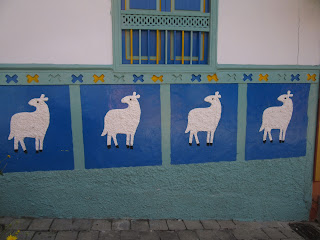















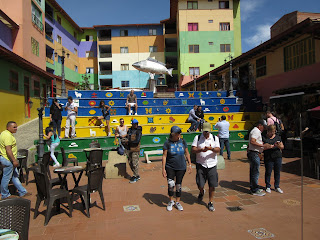
























LOVE the colourful and creative zocalos and the salute to our neighbourhood church Our Lady of Mount Carmel ! And bravo to you and Steven -- up AND down 740 steps.. impressive !! p.s. I am still searching for Steven in the last photo ! (top left step ?)
ReplyDeleteLina,
DeleteYou found him. Hope it didn't strain your eyes!
xoxoxo
DeleteWhat a town, I have never been there, the next visit to Colombia I want to go to Medellin.
ReplyDeleteDid you like the AREPA CON QUESO Y EL CHOCOLATE CALIENTE? Paul likes arepa with cheese and I make them here at home, is one of the Colombian food that he likes.
Bravo! you both, you are in a very good shape to go up and down that amount of steps, congratulation! I love, love the pictures.
Hasta la proxima en Bogota
Gloria,
ReplyDeleteOur day trip from Medellin to Guatape and El Piedra de Guatape was a fabulous one and one of the best things about Medellin for us! I think you'd have a wonderful time also climbing the Rock and taking a boat tour there too.
Love always,
Annie
We didn't attend church on the 27th either, since we were almost in Cape Town, South Africa. Imagine 2 friends from North America in South America and Africa at the same time. Lil Red
ReplyDeleteoops,I meant 9/17/17.
ReplyDeleteLil Red,
ReplyDeleteWe feel like we've followed and will be following you and Pat to so many of the same places you've also been lucky enough to visit. Can't wait to hear about YOUR travels in South Africa, Zimbabwe, etc - places we also loved, dear friend.
At Answers Thanks for this amazing content.
ReplyDeleteSo glad you liked this post and hope you will also enjoy others I have written since then.
ReplyDelete